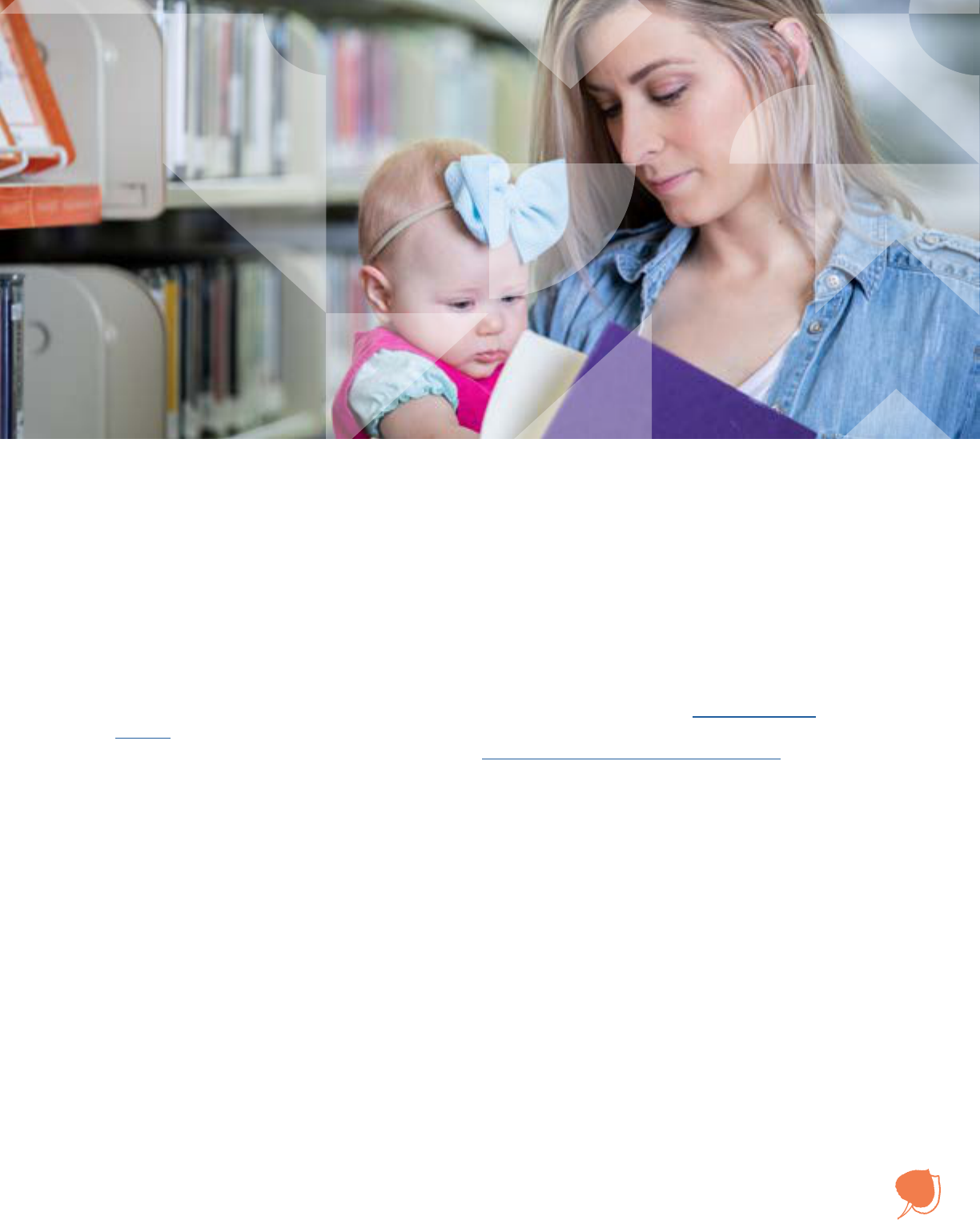
THE MENTAL HEALTH
CHALLENGES EXPERIENCED
BY STUDENT PARENTS
PREPARED FOR THE JED FOUNDATION
BY SHIRLEY LEYRO, PH.D

Ascend’s Mission Statement
Ascend at the Aspen Institute is the
national hub for breakthrough ideas and
collaborations that move children and
their parents toward educational success
and economic security.
Ascend at the Aspen Institute takes a
two-generation approach to its work
and a gender and racial equity lens to
its analysis. Two-generation approaches
provide opportunities for and meet
the needs of children and the adults
in their lives together. We believe that
education, economic supports, social
capital, and health and well-being are
the core elements that create a legacy
of opportunity that passes from one
generation to the next.
Ascend’s Vision Statement
We envision an America in which a legacy
of economic security and educational
success passes from one generation to
the next.
The Jed Foundation’s Mission Statement
JED is a nonprofit that protects emotional
health and prevents suicide for our
nation’s teens and young adults. We’re
partnering with high schools and colleges
to strengthen their mental health,
substance misuse, and suicide prevention
programs and systems. We’re equipping
teens and young adults with the skills and
knowledge to help themselves and each
other. We’re encouraging community
awareness, understanding and action for
young adult mental health.
JED’s Vision Statement
We envision a future where:
Every high school and college has a
comprehensive system that supports
emotional health and reduces the risks
of substance misuse and suicide.
All teens and young adults are
equipped to navigate mental health
challenges, to seek and give help,
and emotionally prepared to enter
adulthood and fulfill their potential.
Our communities support the
emotional well-being and mental
health of teens and young adults.
Mental health is recognized as part of
general health and wellness and is not
associated with shame, secrecy
or prejudice.
ACKNOWLEDGEMENTS
Ascend at the Aspen Institute is grateful for the generosity of its philanthropic partners:
Bezos Family Foundation, the Annie E. Casey Foundation, and the David and Lucile
Packard Foundation. We would also like to thank our collaborators at The Jed
Foundation – Sara Gorman and Kamla Modi.
The Jed Foundation would like to thank Shirley Leyro, Ph.D. for her extensive research
on this literature review as well as Marjorie Sims and David Croom for their continued
support to lift up the voices of students who are parents.

TABLE OF CONTENTS
EXECUTIVE SUMMARY......................................................................................................4
INTRODUCTION................................................................................................................6
METHODOLOGY...............................................................................................................7
THE STUDENT PARENT.......................................................................................................9
MENTAL HEALTH CHALLENGES OF STUDENT PARENTS..................................................10
MENTAL HEALTH CHALLENGES FACED BY THE COLLEGE STUDENT POPULATION.......12
STRESSORS OF PARENTING............................................................................................15
SINGLE PARENTING WHILE ATTENDING COLLEGE........................................................17
FUTURE DIRECTIONS FOR STUDYING THE MENTAL HEALTH
CHALLENGES EXPERIENCED BY STUDENT PARENTS......................................................20
POTENTIAL PARTNERSHIPS..............................................................................................24
CONCLUSION.................................................................................................................26
REFERENCES....................................................................................................................27
APPENDIX A. LIST OF RELEVANT LITERATURE ON THE MENTAL HEALTH
OF STUDENT PARENTS AND INTERSECTING GROUPS....................................................36

Ascend at the Aspen Institute | The JED Foundation 4
A growing segment of the nontraditional student population is the student parent. Data
estimates place the number of college students who are raising a child in the range of
26 to 34 percent. Yet this growing population of college students, while signicant, is still
relatively understudied.
Most of the information about the mental health of student parents is gathered from
survey data. The Hope Center for College, Community, and Justice #RealCollege
Survey found that parents reported experiencing moderately severe to severe levels
of depression, anxiety, and severe anxiety. The National Student Parent Survey
administered by Generation Hope reported that 20 percent felt to varying degrees that
they were unwelcome on their campuses. Also, as chronicled in the 2018 Ascend at
the Aspen Institute September Convening Report, participants of the September 2018
meeting shared feelings of “being an outsider and not being seen or understood by
their school, work, or community” (Alexander, Arnold, & Williams, 2018, p. 5). In addition,
“patterns of trauma surfaced through many of the stories” (p. 4).
In addition to the information obtained from the above survey data, inferences on
the mental health of student parents can be made by exploring the research that
examines the mental health challenges faced by the groups with which the student
parent population intersects: college students and parents. However, any conclusions
will be based on tangential associations conjectured from the data. Designing a study
specically on the mental health of student parents will provide a signicant and
important contribution to the research scholarship in education, psychology, social
work, and public health, which so far has not fully explored the needs of this particular
population of the college community.
EXECUTIVE SUMMARYEXECUTIVE SUMMARY

Ascend at the Aspen Institute | The JED Foundation 5
A mixed-methods study, where both quantitative and qualitative data are collected
in stages, would garner a bounty of information on the mental health challenges
faced by student parents. Additionally, the study should incorporate a two-
generation approach, where the child of the parenting student is also considered. The
intersectionality of race and gender is another important factor to be counted in any
future study examining the mental health of student parents. The social and practical
realities of these intersecting social identities — race, gender, and student group —
present specic and unique implications for the student parent college experience
as well as any associated obstacles. Moreover, the COVID-19 pandemic should also
be considered when developing a study exploring the mental health challenges
experienced by student parents. The COVID-19 crisis has intensied the concerns,
stressors, and obstacles faced by all students.
Finally, collaborating with organizations that have already begun collecting data on
this population might be helpful. Potential partners include The Hope Center located
in Philadelphia and Generation Hope located in Washington, DC. Likewise, partnering
with a university would help with both recruitment and administration of the study.
The City University of New York, with its large and diverse student body and range
of services and programs specically to help parenting students achieve academic
success, would be an ideal partner for a collaborative study exploring the mental
health challenges of student parents.

Ascend at the Aspen Institute | The JED Foundation 6
The term student parent refers to undergraduate students with children under the age of
18 years. The purpose of this literature review is to present the JED team with a synthesis of
the scholarship and an overview of the primary source materials relevant to the mental
health challenges of this particular college community. The summary of work outlined
below is based on the examination of materials provided to me by the team, as well
as an academic investigation of the extant research on the subject matter. I found an
abundance of studies on the mental health of college students in general. There is also
ample research that explores the psychological stressors of parenthood as well as the
mental well-being of single parents, and single mothers in particular. However, as Ascend
at the Aspen Institute states in its Postsecondary Success for Parents mental health brief,
“Research at the intersection of parents and mental health, students and mental health,
and the unique needs of parents who are also students is extremely limited” (2019, p. 1).
Indeed, my own review found a dearth of scholarship that explores the mental health
challenges experienced by student parents as the specic study population.
There is, however, ample descriptive information from survey data, which provides insight
about the size and growth trends of this population. Statistics show that 26 percent of
the undergraduate population — about 1 in 4 undergraduate students — are student
parents, and this student community is growing (Crispin & Nikolaou, 2019; Reichlin Cruse
et al., 2019). Considering the signicant prevalence of student parents, institutions and
policymakers are wise to explore the needs of this college community, as well as the
challenges that might hinder their academic achievement, retention, and degree
completion. In the following paragraphs I will provide an outline of the relevant existing
literature that addresses the mental health challenges faced by student parents in
particular.
1
Although there is a scarcity of literature on this particular college community,
inferences can be made by exploring the research that examines the mental health
challenges faced by the groups with which the student parent population intersects:
college students and parents. Thus, I will also provide a summary of the literature
available on those populations and synthesize it with the extant literature on student
parents. I will then make recommendations for future research.
1 Unless otherwise noted, the population of college students will always be undergraduates.
INTRODUCTIONINTRODUCTION

Ascend at the Aspen Institute | The JED Foundation 7
The strategy used to conduct this literature review is the “exhaustive coverage”
method, which is done to be “as comprehensive as possible … in order to ensure
that all relevant studies … are included in the review and, thus, conclusions are
based on this all-inclusive knowledge base” (Paré et al., 2015, online). To that end,
scholarship in the elds of education, psychology, mental health, social welfare, and
social work were reviewed. A search was conducted of the existing literature for any
studies, articles, or other published material on the subject matter, using the keywords,
“student-parent,” “college parent,” “college student parent,” “parenting student,” and
“mental health” in the queries. Catalogs from the John Jay College of Criminal Justice,
Borough of Manhattan Community College, and The Graduate Center Library websites
were explored. As part of the Graduate Center’s Inter-University Doctoral Consortium,
the databases at Columbia, Fordham, The New School, NYU, Princeton, Rutgers, SUNY
Stony Brook were also accessed (City University of New York Ofce of Library Services
website, 2020, online). Among the major databanks searched were JSTOR, LexisNexis,
PsycInfo, EBSCOhost, and WorldCat.
Suitability of the material to be included in this review was established by setting
the basic standard that the work must be published in a peer-reviewed, ranked
publication. Additionally, unless the investigation or paper introduced new methods,
frameworks, or concepts, no study is older than 10 years. Because of the dearth in
the literature on this particular college community, the conditions for inclusion were
expanded beyond exploring the mental health challenges of the student parent
population to include works that met one of more of the following criteria:
METHODOLOGYMETHODOLOGY
Explores the mental health challenges of parenthood;
Examines the mental well-being of college students;
Studies the psychological health of single parents; or
Researfches the overall challenges (not particularly mental health) faced by
college students, parenting students, and single parents in college.

Ascend at the Aspen Institute | The JED Foundation 8
The initial content analysis search resulted in hundreds of documents and links to
journal articles, books, and other scholarship that matched the keyword query string. I
rst vetted each document by reading the abstracts and/or descriptions. I then read
each of the remaining content pieces and then collated the results according to their
relevance to our population of interest.
Additionally, I reviewed works provided to me by the JED team. I consulted these
materials and then reviewed the reference sections in each in order to retrieve the
primary sources. In total, more than 100 studies, articles, reports, and papers are cited
or referenced in this literature review.
2
The following literature review is a synthesized
summary of my search.
2 A list of the of the relevant literature on the mental health of student parents and intersecting
groups is attached as Appendix A.

Ascend at the Aspen Institute | The JED Foundation 9
The term student parent is not widely used in the literature. Other designations are:
(a) students raising children, (b) students with children, and (c) parenting students
(Goldrick-Rab et al., 2020). When referring to the population of students who are
parents, the scholarship often uses nontraditional. This designation, however, does
not refer solely to students who are parenting while in school, but rather a student
who meets one or more of the seven categories that are considered to be outside of
the traditional student prole (Choy, 2002). These categories are: (1) does not enter
postsecondary education in the same calendar year that he or she nished high
school; (2) attends school part time for at least part of the academic year; (3) works full
time while enrolled; (4) is considered nancially independent for purposes of nancial
aid; (5) has dependents other than a spouse; (6) is a single parent; or (7) does not have
a high school diploma (Choy, 2002, p. 203). Fullling just one of the aforementioned
criteria designates a student as at least “minimally traditional” (Horn, 1996;
Pelletier, 2010).
A growing segment of the nontraditional student population is the student parent. Data
estimates place the number of college students who are raising a child in the range
of 26 to 34 percent (CLASP, 2017; Gault et al., 2014). A secondary analysis of the U.S.
Department of Education National Center for Education Statistics’ 2011-2012 National
Postsecondary Student Aid Study by the Institute for Women’s Policy Research (IWPR)
found that 4,822,748 college students are raising children — a gure representing 26
percent of the undergraduate student population (Gault et al., 2014; Gault, Reichlin,
& Román, 2014). Yet this growing population of college students, while signicant, is still
relatively understudied (Crispin & Nikolaou, 2019; Gerrard & Roberts, 2006).
THE STUDENT PARENTTHE STUDENT PARENT

Ascend at the Aspen Institute | The JED Foundation 10
Several organizations are seeking to identify and address the needs of the parenting
student population. The Hope Center for College, Community, and Justice, based
in Philadelphia and directed by prominent education sociologist Sara Goldrick-
Rab, provides resources to nontraditional students. In 2015, the center created the
“#RealCollege Survey” to help institutions assess students’ basic needs. The most recent
version, administered in fall 2019, included questions about depression and anxiety,
which were elded to a subset of randomly selected respondents. A report of the
survey ndings, published in May 2020, stated that 167,000 students from 171 two-year
institutions and 56 four-year institutions participated. Of the participants, 23,000 — or 16
percent — identied as parenting students and nearly 7,000 identied as single parents.
The report states that “basic needs insecurity is associated with self-reports of poor
physical health, symptoms of depression, and perceptions of higher stress” (Goldrick-
Rab et al., 2020, p. 30). Specically, 30 percent of parenting students reported they
were experiencing depression at the time they were surveyed, and 30 percent
stated they were experiencing moderately severe to severe levels of depression. In
addition, 27 percent were experiencing anxiety, with 13 percent experiencing severe
anxiety. Furthermore, a quarter of respondents reported at least moderate depression
or anxiety related to child care affordability, and 32 percent experienced at least
moderate depression or anxiety associated with basic needs insecurity (Hope Center
Web Appendices, 2020).
In addition, the National Student Parent Survey was administered in 2020 by Generation
Hope, a DC-based community organization aimed at helping teen parents become
college ready. The survey was sent to both past and present cohorts of the Generation
Hope Scholar Program, which selects and sponsors local teen mothers and fathers who
have “displayed achievement and a desire to attend college” (Generation Hope,
2020, online).
MENTAL HEALTH CHALLENGES MENTAL HEALTH CHALLENGES
OF STUDENT PARENTSOF STUDENT PARENTS

Ascend at the Aspen Institute | The JED Foundation 11
The data was collected during March and April 2020. In total, 259 student parents
at more than 147 colleges and universities in the U.S. responded. The survey found
that 40 percent of student parents felt disconnected from their college community,
and less than one-third of respondents said they felt comfortable accessing mental
health services on campus. (Generation Hope, 2020). Furthermore, 20 percent felt to
varying degrees that they were unwelcome on their campuses. Research has found
that a sense of belonging impacts mental well-being (Crocker et al., 1994). Participant
responses indicated that school policies that considered their parental and household
status were important factors that led to them feeling welcome, and more than one-
third did not view their campuses as family friendly.
Belonging was also a theme mentioned in the ndings of the 2018 Ascend at the
Aspen Institute September Convening Report. Parents interviewed at the meeting
held in September 2018 shared feelings of “being an outsider and not being seen or
understood by their school, work, or community” (Alexander, Arnold, & Williams, 2018,
p. 5). In addition, parents expressed feeling pressure and stress related to juggling
the dual roles of parent and student, as well as guilt associated with the pressure
of competing priorities when navigating their dual responsibilities. Participants also
discussed difculties negotiating the challenges of taking care of their own needs and
the needs of their family. Furthermore, “patterns of trauma surfaced through many of
the stories” (p. 4).
Overall, the scholarship on the particular needs and obstacles specic to the student
parent population is scarce. While the dearth of this research makes exploring the
mental health challenges being faced by this subset of the college community difcult,
inferences can be made by reviewing the existing scholarship that examines the lived
experiences and mental health of college students generally, as well as literature on
the psychological challenges of parenthood. In its mental health brief, Ascend at the
Aspen Institute asks, “If becoming a parent and being a postsecondary student are
each linked to potential threats to mental health, what does that mean for students
who are also new parents?” (2019, p. 3). Clearly, it is important to also look at research
that is centered on these intersecting populations. Doing so offers an idea of the
potential challenges experienced by the specic student parent subset. Moreover, the
literature also provides a blueprint for future scholarly investigation of this population.
Below I provide an overview of some of the literature exploring the challenges
experienced by these groups and how we can proceed with future research specic
to the mental health of student parents.

Ascend at the Aspen Institute | The JED Foundation 12
MENTAL HEALTH CHALLENGES FACED MENTAL HEALTH CHALLENGES FACED
BY THE COLLEGE STUDENT POPULATIONBY THE COLLEGE STUDENT POPULATION
Almost 20 percent of the adult population in the United States lives with mental illness
(SAMHSA, 2019). The rates for college students are higher — three out of ve students
report they experience anxiety, and two out of ve students say they felt too depressed
to function (Hibbs & Rostain, 2019; Roy, 2018; ACHA-NCHA II, 2019). During the college
years young adults experience increased vulnerability for a wide range of mental health
challenges (Chen et al., 2019).
In addition, suicide is the second highest cause of death for college students (Heron,
2019). Liu et al. (2018) conducted a secondary analysis of the spring 2015 American
College Health Association-National College Health Assessment (ACHA-NCHA). The
ACHA-NCHA is a national research survey organized by the American College Health
Association (ACHA) “to assist college health service providers, health educators,
counselors, and administrators in collecting data about their students’ habits and
behaviors on the most prevalent health topics” (ACHA-NCHA, 2019, p. 1). By reviewing
67,308 surveys from 108 colleges, ACHA sought to identify the prevalence of mental
health diagnoses and suicidal ideation and attempts among college students. Among
the ndings was that stress was strongly associated with a greater likelihood of suicide
attempts and mental health diagnoses.
In addition, the annual survey of the Association for University and College Counseling
Center Directors (AUCCCD) consistently reports an increase in the number of students
believed to be living with severe psychological problems. AUCCCD is an organization
comprised of leaders of counseling centers of colleges and universities from the United
States and other countries. On its website it states that it “promotes college student
mental health awareness through research, dissemination of key campus mental health
issues and trends, and related training and education” (Rando et al., 2007).

Ascend at the Aspen Institute | The JED Foundation 13
In 2006, AUCCCD created a survey to gather demographic information from afliate
members and to understand what these members considered to be the most important
issues and patterns being addressed at the counseling centers. In the group’s rst
survey, nearly all directors (97 percent) reported that the number of students with
signicant psychological problems is a growing concern in their center or on campus
(Rando et al., 2007). Three years later, in the rst executive summary released with the
survey, the administrators listed anxiety and depression as the top two most frequently
addressed issues (Barr et al., 2010). The most recent results of this survey — taken during
the 2018-2019 year — found that “anxiety continues to be the most frequent concern
among college counseling center clients” (LeViness et al., 2019, p. 1). The survey does
not provide information on how many of the students seen are student parents or
nontraditional students.
For many, the transition into college serves as a unique stressor (Hales, 2009). Becoming
part of the college community has a signicant impact on one’s sense of identity. Group
membership is associated with a sense of belonging, which in turn impacts the sense
of self (Bettencourt et al., 1999; Brewer, 1991; Deaux, 1993; Luhtanen & Crocker, 1992;
Tajfel & Turner, 1986). Collective self-esteem is dened as the “extent to which individuals
evaluate their social groups positively” (Bettencourt et al., p. 213) and has been
found to be positively related to mental well-being (Crocker et al., 1994). The college
experience is considered a pivotal marker during this stage of identity development.
In addition, college students are at an age when they are also particularly at risk for
the onset of anxiety and depression (Beesdo, Knapp, & Pine, 2011). In fact, this phase
represents a high-risk period for onset or episodes of mental disorders in general — 75
percent of all cases begin by age 24 (Kessler et al., 2005; Kim-Cohen et al., 2003).
Moreover, emerging adulthood is a time of increased experimentation with substance
use (Schulenberg et al., 2004; Schulenberg & Maggs, 2002; Tanner, 2015; Wood et
al., 2017).
A recent study by Böke et al. (2019) explored coping mechanisms utilized by college
students. The study collected data from 5,917 undergraduate students of “a large,
urban university where the majority of the students live within close proximity of the
central, downtown campus” (p. 91). Students reported substance use as a coping
mechanism when stress was high.
For those who work with this population — as educators, school administrators, or
campus counselors — these data are of particular concern. The levels of depression,
anxiety, and other mental illnesses experienced by college students impact their ability
to function. These psychological struggles also affect their GPA and retention. The
mental health challenges experienced by college students are numerous and severe.
Within the last two decades, there has been an increase in the number of students
experiencing depression, suicidality, and substance misuse (Chen et al., 2019). The
increase has led researchers and mental health practitioners to declare it a mental
health crisis (Xiao et al., 2017; Pinder-Amaker & Bell, 2012; Schwartz & Kaye, 2009).

Ascend at the Aspen Institute | The JED Foundation 14
As the research presented above has demonstrated, the many obstacles college
students encounter during their time at the university can be contributing factors to
their mental health challenges. When experienced in tandem with the stressors of
raising children, these obstacles may become aggravated and exacerbated. The
pressure, stress, and anxiety parents experience are well documented. Below is a
review of the literature on the strains of parenthood and the compounded difculties
and distress they pose to those who are parenting while in college.

Ascend at the Aspen Institute | The JED Foundation 15
STRESSORS OF PARENTINGSTRESSORS OF PARENTING
In general, the research has found that parenting is an overall positive experience
(Deater-Deckard, 2006; Hayes & Watson, 2012). There are, however, unique challenges
that come with parenthood, and all parents experience parenting stress to some
degree (Crnic & Greenberg, 1990). Consequently, stress is considered to be a
subjective experience — not everyone experiences the same stress, and all individuals
react to stress differently (Folkman & Lazarus, 1985). For some parents, some obstacles
are more difcult to overcome. Deater-Deckard (1998) denes parenting stress as:
The difculties and tensions arising from parenting is perceived to be more intense for
those who have fewer coping skills, as well as for those who do not have a network of
support, such as a partner or other friends or family who can provide emotional and
practical help (Mash & Johnston, 1990).
Much of the literature on mental health and parenthood focuses on single parents. For
purposes of this discussion, single parent households are those that have a sole adult
living with at least one biological, step, or foster child under age 18 (Kramer, 2019). The
amount of research focusing on the single parent is unsurprising to those who look at
the data trends on this subset of the US population. At a rate of almost 25 percent, the
U.S. has the highest number of single-parent households in the world (Kramer, 2019). This
number has been steadily rising since 1968 (Livingston, 2018).
the aversive psychological reaction to the demands of being a parent…
Parenting stress is experienced as negative feelings toward the self and toward
the child or children, and by denition these negative feelings are directly
attributable to the demands of parenthood (p. 315).

Ascend at the Aspen Institute | The JED Foundation 16
Single parents are likely to experience higher levels of stress as well as loneliness,
depression, and anxiety (Baranowska-Rataj et al., 2014; Cairney et al., 2003; Jackson
et al., 2000; Tein et al., 2000). These stressors of single parenting undoubtedly lead to
declining mental health (Folkman & Lazarus, 1980). In addition, single parents face
social stigma, which then shapes their sense of being devalued in society (Crocker et
al., 1998; Livingston, 2018). Indeed, stigma was specically named by the authors of
the National Student Parent Survey Report as a reason why they “did not achieve a
statistically signicant sample size” (Lewis & Haynes, 2020, p. 1). They explained that the
survey yielded relatively few responses because “many students [are] reluctant to share
their parenting status for fear of being treated differently or due to the persistent stigma
around teen parenthood” (Id., p. 2). Further, 21 percent of respondents stated they
were somewhat or very uncomfortable disclosing their parenting status to professors.
Moreover, in the Ascend at the Aspen Institute September Convening Report, the
authors report that “many parents shared that stigma and shame serve as both barriers
and motivation on their post-secondary path” (Alexander, Arnold, & Williams, 2018, p.
9). In addition, the report quoted one parent who said that being a single parent is a
“‘scarlet letter’” (Id., p. 5). This social stigma is faced most often by single mothers. In
a study exploring attitudes toward single mothers and fathers, DeJean, McGeorge, &
Carlson (2012) found that single mothers were seen more negatively than single fathers.
Single-parent families also face high rates of economic hardship. U.S. census data show
that married parents are the most nancially stable unit of all the family groups with
children under the age of 18 (Vespa et al., 2013). The rates of poverty for single-parent
families are signicantly higher than for dual-parent households (Shenoy et al., 2016).
Economic disadvantage is higher for single mothers than for single fathers (Vespa, 2013).
One path away from poverty is obtaining a university education. Pursuing a college
degree is considered a determinant factor for upward mobility (Abowitz, 2004). In the
analysis of U.S. census data on the economic standing of dual- versus single-family
households, Vespa et al. (2013) list a college education as a factor for this advantaged
economic position. In addition, single fathers fare better economically than single
mothers, and “better educational attainment” is listed as a reason this difference exists
(Vespa, 2013, p. 13). Single parenting, combined with the stressors that come with being
a college student as well as the primary household provider, are compound factors that
warrant exploration. For those who study mental health, single-parent college students
are a population of considerable interest.

Ascend at the Aspen Institute | The JED Foundation 17
SINGLE PARENTING WHILE SINGLE PARENTING WHILE
ATTENDING COLLEGE ATTENDING COLLEGE
Single-parenting students are an emerging subset of the larger college population, and
the mental health challenges they face are unique (Huff & Thorpe, 1997; Shenoy et al.,
2016). The data referenced above demonstrate that single parents are vulnerable to
the strains that cause parenting stress generally, as well as to more distinctive burdens
resulting from the compounded effects of being sole caregivers. These unique strains
include economic hardship, social stigma, and increased loneliness.
In fact, a review of extant literature available on the psychological problems faced by
student parents found that most of the research examines the experiences of single
parents. This research focus is consistent with the student parent population data, which
shows that single parents constitute the majority of students who are raising children
(Goldrick-Rab et al., 2020). The previously cited 2014 IWPR factsheet shows that of the
over 4.8 million student parents, 2,582,340 — or 54 percent — are single parents.
Several studies that name student parents, or single parents, as the study population
explore the experiences of those at community colleges (Peterson, 2016; Ray et al.,
2000). This nding also accords with the data, which show that 15 percent of community
college students are single parents (AACC, 2019). Almost half of all the undergraduate
students in the United States attend community colleges (AACC, 2014). In their study
on The Mental Health Status of Single-Parent Community College Students in California,
Shenoy, Lee, and Trieu (2016) address the gap in the literature for single-parent student
mental health. They state:

Ascend at the Aspen Institute | The JED Foundation 18
To answer the above, Shenoy et al. (2016) conducted a secondary analysis of spring
2013 data from the ACHA-NCHA, as well as an analysis of a supplemental questionnaire
to the survey created by Health Services Association of California Community Colleges
(HSACCC). One of the items on the supplemental questionnaire asked the binary-
response question, “Are you currently a single parent, responsible for taking care of and
nancially supporting a dependent child (or children) under the age of 18?” (p. 153).
Among the ndings were that single-parenting students face a higher prevalence of
mental health stressors than other community college students.
Most of the literature on single parents focuses on single mothers (Haleman, 2004;
Yakaboski, 2010). Historically speaking, women have traditionally been tasked with
being the primary family caregivers (Blair-Loy, 2001; Coser & Coser, 1974; Hays, 1996;
Townsend, 2002). In the world of research, when studying parenting, the tacit study
group is the mother (Pedulla & Thébaud, 2015; Stone, 2007). In fact, even when
operationalizing studies that seek to examine views of parenting, the main population is
mothers. For example, the Intensive Parenting Attitudes Questionnaire (IPAQ), created
to “help researchers gain a better understanding of the predictors and consequences
of holding intensive parenting beliefs,” uses mothers as its study population (Liss et al.,
2013, p. 621).
The fact that single mothers are the principal focus of the scholarship exploring the
single-parent student experience is also consistent with the data on the composition of
the single-parent student population — in 2014, 22 percent of the nine million mother-
only parent families in the United States were college students (Gault et al., 2014). In
addition, a 2018 analysis of the U.S. Department of Education’s National Postsecondary
Student Aid Study by IWPR found that 70 percent of student parents are mothers, and
of those 62 percent are single (IWPR, 2018).
Research ndings on the lived experiences of single mothers frequently report mental
health impacts, even when the study is not specic to psychological well-being. For
example, a qualitative study of 27 mothers recruited from an academic institution in
the mid-Atlantic region of the U.S. (Kensinger & Minnick, 2018, p. 135) explored student
mothers’ experiences in college. The study named the lack of nancial resources as a
barrier to completing college. Mental health was not directly explored. Nevertheless,
the researchers found that increased emotional support was a chief determinant of
success in college.
In addition, in a qualitative study of 12 women who were student parents, Gerrard
and Roberts (2006) sought to explore the consequences of nancial hardship on their
lives. Most participants responded that their economic situation impacted their mental
well-being — they reported signicant levels of stress and a diminished quality of life.
The mothers also stated that the negative impact on their psychological well-being
transferred over to their children.
Questions remain. For single-parenting students, what are the rates and severity
of stress, depression, and other mental health conditions? What can college
health professionals do to help ensure that such students are healthy and have
the social support necessary to achieve academically and prepare for the
workforce? (p. 152).

Ascend at the Aspen Institute | The JED Foundation 19
Certainly, while the literature that looks specically at the mental health challenges
faced by student parents is scarce, inferences can be made about their psychological
well-being by reviewing the scholarship of the groups that have overlapping statuses.
The research on college students generally, parents, and single-parent students informs
us of the signicant mental health challenges faced by the student parent population.
However, in order to truly understand the psychological issues and obstacles that
student parents face, further research should be conducted.

Ascend at the Aspen Institute | The JED Foundation 20
FUTURE DIRECTIONS FOR STUDYING FUTURE DIRECTIONS FOR STUDYING
THE MENTAL HEALTH CHALLENGES THE MENTAL HEALTH CHALLENGES
EXPERIENCED BY STUDENT PARENTS EXPERIENCED BY STUDENT PARENTS
Thus far, the overview of scholarship summarized in this paper has outlined the limited
literature on the mental health challenges of student parents specically, as well as the
existing research that explores the experiences and challenges of college students in
general, the stressors of parenthood, single parenting, and the experiences of students
who are single parents. In addition, as cited above, national databases run by several
university-afliated organizations, as well as community-based organizations, are
collecting data on the needs of student parents. However, as demonstrated, all of the
scholarship, research, and data is limited to some degree as it relates to the topic of this
literature review. Clearly, when considering the challenges faced by those who are both
a college student and a parent, the psychological realities faced by student parents
are signicant. However, these conclusions are based mostly on descriptive statistics and
tangential associations inferred from the data. In addition, any qualitative research is
based on small sample sizes, which limits the potential for generalizability.
A mixed-methods study where both quantitative and qualitative data are collected in
stages would garner a bounty of information on the mental health challenges faced
by student parents. As a rst phase, data collection using a survey designed to assess
mental health can be administered. One such instrument could be the Collective
Self-Esteem Scale (CSES). As mentioned above, group membership is associated
with the sense of belonging, which in turn impacts the sense of self and is considered
fundamental to psychological well-being. The CSES was constructed to measure a
person’s memberships to ascribed groups, such as race, gender, and nationality, and
has been used to assess well-being and adjustment (Bettencourt, 1999; Crocker et al.,
1994; Luhtanen & Crocker, 1992).

Ascend at the Aspen Institute | The JED Foundation 21
The scale is a 16-item instrument measuring four types of self-esteem associated with
one’s group: (1) membership esteem — how good or worthy a member of the group
one is; (2) private collective self-esteem — how one personally evaluates their group (3)
public collective self-esteem — how one believes others evaluate one’s social groups;
(4) importance to identity — how important one’s group is to one’s self concept
(Luthanen & Crocker, 1992). All items are answered on a 7-point Likert scale ranging
from 1 (strongly disagree) to 7 (strongly agree). Bettencourt et al. (1999) used the CSES
to examine if collective self-esteem inuences adjustment to college.
A customized version of the CSES, modied to ask questions of the student parent
population, can be used to further explore and examine ndings from previous surveys.
For example, the 2020 National Student Parent Survey administered by Generation
Hope, cited earlier, found feelings of not belonging to be a signicant nding. The CSES
can provide insight and unravel more about this particular discovery. Adjusting the
survey to also include questions specically about mental health would give insight into
the mental well-being of student parents.
Knowing the scope of the issue is certainly helpful, but only through a deep
examination of the issues students face via qualitative exploration and analyses will we
gather the rich contextual information we need. Phase two of the study would be in-
depth interviews of a sample of the survey respondents. Speaking to the participants of
the study using semi-structured questions designed to allow them to expound on their
survey replies will result in a richer understanding of the issues they face. In addition,
doing so would help policymakers, school faculty, administrators, and counselors,
as well as local organizations concerned with this population, use the information to
devise programs and initiatives that will address the very specic needs mentioned by
this college community.
An important factor to be included in this multi-staged, mixed-methods study
specically exploring the mental health of student parents is their children.
Incorporating a two-generation approach to study this population will address some of
the needs expressed by parents in studies exploring attitudes of parenting students. For
example, Lindsay and Gillum (2018) conducted a qualitative study of 10 single mothers
at “a university in the northern part of Texas” (p. 191). Among their ndings was that
the students wanted the university to consider both their individuality as students and
their children. While mental health was not mentioned in the study, these ndings are
relevant, as the literature has established that parenting stress can be alleviated when
supportive networks are present (Mash & Johnston, 1990). These ndings related to
child care, and a supportive infrastructure by the university is consistent with results from
the National Student Parent Survey, cited previously. As mentioned above, respondents
reported that school policies where parenting is supported are important to them, and
one in three student parents did not view their campus as family friendly. Indeed, in a
paper sponsored by Ascend at the Aspen Institute, Kim and Watamura (2015) strongly
encourage the two-generation approach. They state:

Ascend at the Aspen Institute | The JED Foundation 22
Most commonly, programs that target parents are not coupled with programs
that target children. Increasingly, this disconnect in services … has been
challenged as illogical and inefcient, and efforts to provide integrated and
explicit two-generation interventions have been increasing (p. 5).
Factoring the children of the student parent into any analysis of their experiences and
mental health challenges is important, particularly when considering that the stressors
of parenting can impact the children. Adjustment to adulthood is directly related to
experiences with parents (Creasey & Reese, 1996; Quittner, Glueckauf, & Jackson,
1990). A child’s problem behaviors, temperament, emotional adjustment, and future
substance use have been found to be associated with the parent-child relationship
(Pesonen et al., 2008; VanderValk et al., 2007; Wills & Dishion, 2004; Zhang et al., 2008).
Parental depression, marital problems, and parenting practices have been found to be
inuences that impact a child’s developmental process (Brody & Ge, 2001; Gross et al.,
2008). A study by Neece, Green, and Baker (2012) explored the transactional effect of
parenting stress on child behavior. By analyzing longitudinal data on 237 children, they
found evidence of a relationship between parental stress and child behavioral problems
across early and middle childhood.
Another factor to consider in future studies should be whether the child has a
developmental issue. Research has found that parental stress increases when the
child has a disability (Hayes & Watson, 2012; Watson et al., 2011). Research on the
experiences of families of children with disabilities most commonly use parenting stress as
the topic (Davis &Carter, 2008; Pisula, 2003). Moreover, the type of disability of the child
is a factor in the levels of parenting stress. Hayes and Watson (2013) conducted a meta-
analysis of studies comparing parenting stress in families of children with autism spectrum
disorder (ASD) to families with children who do not have ASD. They also compared
families with a child who had ASD with families with a child who had a different type of
disability. They found greater parenting stress among the families that had a child with
ASD in both comparisons. Thus, when exploring the psychological well-being of student
parents, it is important to incorporate the two-generation approach in order to include
information regarding their children and any other environmental elements that might
impact stress.
Moreover, any future study examining the mental health of student parents must
consider the intersectionality of race and gender as complex and contributing factors
to the challenges experienced by this college population. The social and practical
realities of these intersecting social identities — race, gender, and student group —
present specic and unique implications for the student parent college experience,
as well as any associated obstacles. In fact, student parents are more likely to be
Black, and Black women in particular are more likely to be parenting while in college
(Goldrick-Rab et al., 2020; Lewis & Haynes, 2020; Reichlin Cruse et al., 2019).

Ascend at the Aspen Institute | The JED Foundation 23
Additionally, while the National Student Parent Survey found that one-third of parents
did not nd their campuses to be family friendly, that number increases to 45 percent
when disaggregating for Black parenting students (Lewis & Haynes, 2015). Furthermore,
Black student parents hold more student debt than other parents, or nonparents, of
every other race or ethnicity (Reichlin Cruse et al., 2019). Lastly, Chen et al. (2019) found
that racial-ethnic minority students may be at high risk of undetected mental illnesses.
In addition, they found that Asian/Pacic Islander and multiracial students seem to
have higher rates of negative mental health symptoms, including suicidal ideation
and suicide attempts. Clearly, the statistics show that in most areas that have been
found to impact the mental health of parenting students, race is a factor that must be
considered in any and all future research studies.
The COVID-19 pandemic should be considered when developing a study exploring the
mental health challenges students experience. Educational institutions were signicantly
impacted by this event, from having to abruptly pause classes to devising — mostly
from the ground up — new pedagogical practices related to the logistical realities of
distance learning. The services provided to students on college campuses were severely
curtailed. Students who have relied on counseling services had to seek services via an
online platform, if they could access those services at all (Blankenberger & Williams,
2020). In addition, the devastating economic impact inicted by the compulsory
quarantine drove many families into nancial destruction. An already unstable housing
situation was exacerbated, and the seclusion and separation forced by the crisis drove
many to experience increased levels of isolation and depression. Moreover, student
parents were forced to homeschool their children while having to complete their own
studies. The tumultuous transition to online learning forced parents to become de facto
teachers, multiplying their workload as caregivers (St. Armour, 2020). Essentially, the
COVID-19 crisis intensied the concerns, stressors, and obstacles that all students, and
undoubtedly the student parent population, face. No analysis of the student parent
experience, much less the mental challenges faced by this population, can ignore the
impact of the crisis.

Ascend at the Aspen Institute | The JED Foundation 24
POTENTIAL PARTNERSHIPSPOTENTIAL PARTNERSHIPS
Finally, the JED team might benet from collaborating with organizations that have
already begun collecting data on this population. Potential partners include The
Hope Center located in Philadelphia and Generation Hope located in Washington,
DC. Each organization has collected and continues to gather data on the student
parent population. Teaming up with either or both groups could help with recruiting
participants for the study, as well as with the development and administration of the
survey instrument.
Partnering with a university would also assist in recruiting students for the study. One
such collaboration could be with The City University of New York (CUNY). CUNY is the
nation’s largest urban university, with over a quarter of a million students in 11 senior
colleges and seven community colleges across the ve boroughs of New York City
(CUNY, 2020, online). The CUNY student body is diverse — 21 percent Asian, 25 percent
Black, 31 percent Hispanic, 23 percent white (CUNY Ofce of Institutional Research and
Assessment, 2020). Almost half of the student body are rst-generation students. While
exact data on how many students are parenting while in college is not available, the
latest available CUNY student experience survey reports that 12 percent of the 25,242
respondents support children (CUNY Ofce of Institutional Research and
Assessment, 2016).
CUNY has several programs and services that try to meet the needs of parenting
students. There are child care services on 17 of its campuses (Willen, 2020). The CUNY
Fatherhood Academy, which is housed in three of the community colleges, is “designed
to promote responsible parenting and economic stability for unemployed and
underemployed fathers ages 18-30, through education, employment, and personal
development” (CUNY, 2020, online). The CUNY Parents task force aims to “identify
resources for student-parents … develop student-faculty policies … and promote
engagement with key stakeholders involved in promoting the success of student-
parents” (CUNY Parents, 2018, online).

Ascend at the Aspen Institute | The JED Foundation 25
The Family Empowerment Community College Pilot Program is funded by the New York
state government and is intended to “ensure that single parents are able to access
higher education opportunities and help to move themselves and their children out
of poverty” (NYS Justice Agenda, 2019, p. 19). The program provides on-campus
child care; personalized advising, including tutoring; and career counseling. The pilot
began in the fall of 2019 at four CUNY community colleges. With such a large and
diverse student body and a range of services and programs aimed specically to
help parenting students achieve academic success, CUNY is an ideal partner for a
collaborative study exploring the mental health challenges of student parents.

Ascend at the Aspen Institute | The JED Foundation 26
CONCLUSIONCONCLUSION
In conclusion, the literature on the experiences of college students, as well as
parenthood, provide information on the range of challenges student parents face.
Moreover, based on the research on the mental health issues that college students,
parents generally, and single parents face, we can extrapolate that student parents
face a wide array of mental health challenges. These include, among others, elevated
levels of anxiety, depression, and substance misuse. Designing a study specically
focusing on student parents, and in particular their mental health, will signicantly
contribute to the research scholarship in education, psychology, social work, and
public health, which so far has not fully explored the needs of this particular college
population. Moreover, the study will help administrators, school counselors, faculty, and
local organizations concerned with addressing the basic needs of the student parent
community devise programs and policies aimed at addressing the challenges this
group confronts.

Ascend at the Aspen Institute | The JED Foundation 27
REFERENCESREFERENCES
Abowitz, D. A. (2005). Social mobility and the American Dream: What do college
students believe? College Student Journal, 39, 716–728.
Alexander, J., Arnold, B., & Williams D. (2019). Ascend at the Aspen Institute
September convening report. Public Agency at West Michigan Center for Arts
+ Technology (WMCAT).
American Association of Community Colleges. 2014 fact sheet. Washington, DC:
American Association of Community Colleges. Retrieved from:
https://www.napicaacc.com/docs/AACC_Fact_Sheet_2016.pdf.
American College Health Association. American College Health Association-National
College Health Assessment III: Reference group executive summary spring
2020. Silver Spring, MD: American College Health Association. Retrieved from:
https://www.acha.org/documents/ncha/NCHA-III_Fall_2019_Reference_Group_
Executive_Summary.pdf.
Ascend at the Aspen Institute. (2019, April). Mental Health Brief. Accelerating
postsecondary success for parents: Identifying and addressing mental health
needs.
Baranowska-Rataj, A., Matysiak, A., & Mynarska, M. (2014). Does lone motherhood
decrease women’s happiness? Evidence from qualitative and quantitative
research. Journal of Happiness Studies, 15(6), 1457–1477. doi:10.1007/s10902-
013-9486-z.
Barr, V., Rando, R., Krylowicz, B., & Reetz, D. (2010). Report of the Association for
University and College Counseling Center Directors Annual Survey. Retrieved
from:
http://les.cmcglobal.com/aucccd_directors_survey_monograph_2010_public.pdf.
Beesdo, K., Knappe, S., & Pine, D. S. (2009). Anxiety and anxiety disorders in children
and adolescents: Developmental issues and implications for
DSM-V. The Psychiatric Clinics of North America, 32(3), 483–524. doi.
org/10.1016/j.psc.2009.06.002.
Bettencourt, B. A., Charlton, K., Eubanks, J., Kernahan, C., & Fuller, B. (1999).
Development of collective self-esteem among students: Predicting
adjustment to college. Basic and Applied Social Psychology, 21(3), 213–222. doi.
org/10.1207/15324839951036380.
Blair-Loy, M. (2001). Cultural constructions of family schemas: The case of women
nance executives. Gender & Society, 15(5), 687–709.
Blankenberger, B., & Williams, A. M. (2020). COVID and the impact on higher education:
The essential role of integrity and accountability. Administrative Theory & Praxis,
42(3), 404–423. doi: 10.1080/10841806.2020.1771907.

Ascend at the Aspen Institute | The JED Foundation 28
Böke, N. B., Mills, D. J., Metller, J., & Heath, N. L. (2019). Stress and coping patterns of
university students. Journal of College Student Development, 60(1), 85–103.
doi:10.1353/csd.2019.0005.
Brewer, M. B. (1991). The social self: On being the same and different at the same time.
Personality and Social Psychology Bulletin, 17, 475–482.
Brody, G. H., & Ge, X. (2001). Linking parenting processes and self-regulation to
psychological functioning and alcohol use during early adolescence. Journal of
Family Psychology, 15(1), 82–94. doi.org/10.1037/0893-3200.15.1.82.
Cairney J., Boyle M. H., Lipman E. L., & Racine Y. (2004). Single mothers and the use of
professionals for mental health care reasons. Social Science & Medicine, 59(12),
2535–2546.
Cairney, J., Boyle, M., Offord, D. R., & Racine, Y. (2003). Stress, social support
and depression in single and married mothers. Social Psychiatry and Psychiatric
Epidemiology: The International Journal for Research in Social and
Genetic Epidemiology and Mental Health Services, 38(8), 442–449.
doi.org/10.1007/s00127-003-0661-0.
Chen, J. A., Stevens, C., Wong, S., & Liu, C. H. (2019). Psychiatric symptoms and
diagnoses among U.S. college students: A comparison by race and ethnicity.
Psychiatric Services, 70(6), 442–449. doi.org/10.1176/appi.ps.201800388.
Choy, S. (2002). Nontraditional Undergraduates (NCES 2002-012). National Center for
Education Statistics, U.S. Department of Education. Washington, DC.
City University of New York Fatherhood Academy Website. Retrieved August 30, 2020,
from:
https://www.cuny.edu/academics/academic-programs/model-programs/cuny-
fatherhood-academy/.
City University of New York Library Website. Retrieved August 30, 2020, from:
https://www.cuny.edu/about/administration/ofces/library-services/.
City University of New York Ofce of Institutional Research and Assessment. 2016 Student
Experience Survey. Retrieved from:
https://www.cuny.edu/wp-content/uploads/sites/4/page-assets/about/administration/
ofces/oira/institutional/surveys/2016_SES_Highlights_Updated_web_ready.pdf.
CLASP. (2017). [Table depiction of “College Students Aren’t Who You Think They Are”
Factsheet]. Center for Postsecondary and Economic Success. Retrieved from:
https://www.clasp.org/sites/default/les/publications/2017/08/2017June_
CollegeStudentsArentWhoYouThinkTheyAre.pdf.
Coser, L. A., & Coser, R. L., (1974). The housewife and her greedy family. In Lewis A.
Coser (Ed.), Greedy institutions. New York: Free Press.

Ascend at the Aspen Institute | The JED Foundation 29
Creasey, G., & Reese, M. (1996). Mothers’ and fathers’ perceptions of parenting hassles:
Associations with psychological symptoms, nonparenting hassles, and child
behavior problems. Journal of Applied Developmental Psychology, 17, 393–406.
Crispin, L. M., & Nikolaou, M. (2019, February). Balancing college and kids: Estimating
time allocation differences for college students with and without children,
Monthly Labor Review. U.S. Bureau of Labor Statistics. doi.org/10.21916
/mlr.2019.3.
Crnic, K., & Greenberg, M. (1990). Minor parenting stress with young children. Child
Development, 54, 209–217.
Crocker, J., Luhtanen, R., Blaine, B., & Broadnax, S. (1994). Collective self-esteem and
psychological well-being among White, Black, and Asian
college students. Personality and Social Psychology Bulletin, 20(5), 503–513. doi.
org/10.1177/0146167294205007.
Crocker, J., Major, B., & Steele, C. (1998). Social stigma. In D. Gilbert, S. Fiske, & G.
Lindzey (Eds.), Handbook of social psychology (4th ed., Vol. 2, pp. 504–553). New
York: McGraw-Hill. doi:10.1002/9780470561119.
CUNY Parents Mission Statement. Retrieved August 30, 2020, from:
https://www.cunyparents.com/mission.
Davis, N. O., & Carter, A. S. (2008). Parenting stress in mothers and fathers of toddlers
with autism spectrum disorders: Associations with child characteristics. Journal of
Autism Developmental Disorders, 38, 1278–1291.
Deater-Deckard, K. (1998). Parenting stress and child adjustment: Some old hypotheses
and new questions. Clinical Psychology, Science and Practice, 5, 314–332.
DeJean, S., McGeorge, C., & Carlson, T. (2012). Attitudes toward never-married single
mothers and fathers: Does gender matter? Journal of Feminist Family Therapy:
An International Forum, 24(2), 121–138. doi: 10.1080/08952833.2012.648121.
Folkman, S., & Lazarus, R. S. (1980). An analysis of coping in a middle-aged community
sample. Journal of Health and Social Behavior, 219–239. doi:10.2307/2136617.
Gault, B., Reichlin Cruse, L., Reynolds, E., & Froehner, M. (2014, November). 4.8 million
college students are raising children. Fact Sheet #C424. Institute for Women’s
Policy Research. Retrieved from:
https://www.luminafoundation.org/wp-content/uploads/2017/08/college-students-
raising-children.pdf.
Gault, B., Reichlin, L., & Román, S. (2014). College affordability for low-income
adults: Improving returns on investment for families and society. Report, IWPR
#C412. Washington, DC: Institute for Women’s Policy Research.

Ascend at the Aspen Institute | The JED Foundation 30
Generation Hope. (2020, May 13). Report ndings and recommendations: Uncovering
the student parent experience and its impact on college success. Retrieved
from:
http:// supportgenerationhope.org/blog/2020/5/8/report.
Generation Hope Mission Statement. Retrieved July 15, 2020, from:
https://static1.squarespace.com/static/50363015e4b09af678ee8675/t/5d9b9e0bbedf5
00de3aaa06c/1570479627387/Generation+Hope+Overview+and+Impact_Rev+08.2019.
pdf.
Gerrard, E., & Roberts, R. (2006). Student parents, hardship and debt: A qualitative
study. Journal of Further and Higher Education, 30(4), 393–403.
doi:10.1080/03098770600965409.
Goldrick-Rab, S., Welton, C. R., & Coca, V. (2020). Parenting while in college: Basic
needs insecurity among students with children. Retrieved from:
https://hope4college.com/wp-content/uploads/2020/05/2019_
ParentingStudentsReport.pdf.
Gross, H. E., Shaw, D. S., & Moilanen, K. L. (2008). Reciprocal associations between boys’
externalizing problems and mothers’ depressive symptoms. Journal of Abnormal
Child Psychology, 36, 693–709.
Haleman, D. L. (2004). Great expectations: single mothers in higher education.
International Journal of Qualitative Studies in Education, 17(6), 769–784. doi:
10.1080/0951839042000256448.
Hales, D. (2009). An invitation to health, 13th Ed. Belmont, CA: Wadsworth/Cengage
Learning.
Hayes, S.A., & Watson, S.L. (2013). The impact of parenting stress: A meta-analysis of
studies comparing the experience of parenting stress in parents of children with
and without autism spectrum disorder. Journal of Autism and
Developmental Disorders, 43, 629–642. doi-org.ez.lib.jjay.cuny.
edu/10.1007/s10803-012-1604-y.
Hays, S. (1996). The cultural contradictions of motherhood. Yale University Press.
Heron, M. (2019). Deaths: Leading causes for 2017. National Vital Statistics Reports, 68(6).
Hyattsville, MD: National Center for Health Statistics.
Hibbs, B. J., & Rostain, A. (2019). The stressed years of their lives: Helping your kid survive
and thrive during their college years. New York, NY: St. Martin’s Press.
Hope Center for College, Community, and Justice. Web Appendices to Parenting While
In College: Basic Needs Insecurity Among Students With Children. Retrieved from:
https://hope4college.com/wp-content/uploads/2020/05/RC2019-
ParentingStdlAppendices_FINAL.pdf.

Ascend at the Aspen Institute | The JED Foundation 31
Huff, D. D., & Thorpe, B. (1997). Single parents on campus: A challenge for today. NASPA
Journal, 34(4), 287–302. doi: 10.2202/1949-6605.1031.
Institute for Women’s Policy Research (IWPR). (2018). Institute for Women’s Policy
Research analysis of data from the U.S. Department of Education,
National Center for Education Statistics, 2015–16 National
Postsecondary Student Aid Study.
Jackson, A. P., Brooks-Gunn, J., Huang, C., & Glassman, M. (2000). Single mothers
in low-wage jobs: Financial strain, parenting, and preschoolers’ outcomes. Child
Development, 7(5),1409–1423. doi:10.1111/1467-8624.00236.
Kensinger, C., & Minnick, D. J. (2018). The invisible village: An exploration of
undergraduate student mothers’ experiences. Journal of Family and Economic
Issues, 39, 132–144. doi.org/10.1007/s10834-017-9535-6.
Kessler, R. C., Berglund, P., Demler, O., Jin, R., & Walters, E. E. (2005). Prevalence and
age- of-onset distributions of DSM-IV disorders in the National Comorbidity Survey
Replication. Archives of General Psychiatry, 62, 593–602.
Kim, P., & Watamura, S. E. (2015, June). Two Open Windows: Infant and Parent
Neurobiologic Change. Report from the Ascend at The Aspen Institute. Retrieved
from:
https://ascend.aspeninstitute.org/wp-content/uploads/2017/10/4b320cff0e86d8fb51_
gqm6btprv-6.pdf
Kim-Cohen, J., Caspi, A., Moftt, T. E., Harrington, H., Milne, B. J., & Poulton, R. (2003).
Prior juvenile diagnoses in adults with mental disorder: Developmental
follow-back of a prospective-longitudinal cohort. Archives of General Psychiatry,
607(7), 709–717.
Kramer, S. (2019, December 12). U.S. has world’s highest rate of children living in single-
parent households. Report from the Pew Research Center. Retrieved from:
https://www.pewresearch. org/fact-tank/2019/12/12/u-s-children-more-likely-than-
children-in-other-countries-to-live-with-just-one-parent/.
LeViness, P., Gorman, K., Braun, L., Koenig, L., & Bershad, C. (2019). Report of the
Association for University and College Counseling Center Directors Annual
Survey: 2019. Retrieved from:
https://www.aucccd.org/assets/documents/Survey/2019%20AUCCCD%20Survey-2020-
05-31-PUBLIC.pdf.
Lewis, N. L., & Haynes, D. (2020). Generation Hope National Student-Parent Survey
results & recommendations: Uncovering the student-parent experience and its
impact on college success. Retrieved from:
https://static1.squarespace.com/static/50363015e4b09af678ee8675/t/5ebb60b839793d1
dee21ee12/1589338301092/GH_%23StudentParentSuccess+Report_single+pgs_Final.pdf.

Ascend at the Aspen Institute | The JED Foundation 32
Lindsay, T. N., & Gillum, N. L. (2018). Exploring single-mother college students’
perceptions of their college-related experiences and of campus services.
Journal of Continuing Higher Education, 66(3), 188–199.
Liss, M., Schiffrin, H. H., Mackintosh, V. H., Miles-McLean, H., & Erchull, M. J. (2013).
Development and validation of a quantitative measure of intensive parenting
attitudes. Journal of Child and Family Studies, 22, 621–636.
doi.org/10.1007/s10826-012-9616-y.
Liu, C. H., Stevens, C., Wong, S. H. M., Yasui, M., & Chen, J. A. (2019). The prevalence
and predictors of mental health diagnoses and suicide among U.S. college
students: Implications for addressing disparities in service use. Depression
and Anxiety, 36(1), 8–17. doi:10.1002/da.22830.
Livingston, G. (2018, April 27). About one-third of U.S. children are living with an
unmarried parent. Report from the Pew Research Center. Retrieved from:
https://www.pewresearch.org/fact-tank/2018/04/27/about-one-third-of-u-s-children-
are-living-with-an-unmarried-parent/.
Livingston, G. (2018, April 25). The changing prole of unmarried parents. Report from
the Pew Research Center. Retrieved from:
https://www.pewsocialtrends.org/2018/04/25/the-changing-prole-of-unmarried-
parents/.
Luhtanen, R., & Crocker, J. (1992). A collective self-esteem scale: Self-evaluation of
one’s social identity. Personality and Social Psychology Bulletin, 18(3), 302–318.
doi.org/10.1177/0146167292183006.
Mash, E. J., & Johnston, C. (1990). Determinants of parenting stress: Illustrations from
families of hyperactive children and families of physically abused children.
Journal of Clinical Child Psychology, 19, 303–328
Mister, B. J., Reetz, D. R., Krylowicz, B., & Barr, V. (2012). Report of the Association for
University and College Counseling Center Directors Annual Survey. Retrieved
from:
http://les.cmcglobal.com/Monograph_2012_AUCCCD_Public.pdf.
Neece, C. L., Green, S. A., & Baker, B. L. (2012). Parenting stress and child behavior
problems: A transactional relationship across time. American Journal on
Intellectual and Developmental Disabilities, 117(1), 48–66. doi.org/10.1352/1944-
7558-117.1.48.
Pedulla, D. S., & Thébaud, S. (2015). Can we nish the revolution? Gender, work-
family ideals, and institutional constraint. American Sociological Review,
80(1), 116–139.
Paré, G., Trudel, M. C., Jaana, M., & Kitsiou, S. (2015). Synthesizing information systems
knowledge: A typology of literature reviews. Information & Management, 52(2),
183–199.

Ascend at the Aspen Institute | The JED Foundation 33
Pelletier, S. G. (2010, Fall). Traditional or non-traditional? What’s the difference? Public
Purpose Magazine.
Pesonen, A., Räikkönen, K., Heinonen, K., Komsi, N., Järvenpää, A., & Strandberg,
T. A. (2008). A transactional model of temperamental development: Evidence of
a relationship between child temperament and maternal stress over ve years.
Social Development, 17, 326–340.
Peterson, S. (2016). Community college student-parents: Priorities for persistence.
Community College Journal of Research and Practice, 40(5), 370–384. doi:
10.1080/10668926.2015.1065210.
Pinder-Amaker, S., & Bell, C. (2012). A bioecological systems approach for navigating
the college mental health crisis. Harvard Review of Psychiatry, 20, 174–188.
Pisula, E. (2003). Parents of children with autism—Review of current research. Archives of
Psychiatry and Psychotherapy, 5(4), 51–63.
Quittner, A. L., Glueckauf, R. L., & Jackson, D. N. (1990). Chronic parenting stress:
Moderating versus mediating effects of social support. Journal of Personality and
Social Psychology, 59, 1266–1278.
Rando, R., Barr, V., & Aros, C. (2007). Report of the Association for University and College
Counseling Center Directors Annual Survey. Retrieved from:
http://les.cmcglobal.com/monograph_2007_public.pdf.
Ray, D., Bratton, S. C., & Brandt, M. A. (2010). Filial/family play therapy for single parents
of young children attending community colleges. Community College Journal of
Research and Practice, 24, 469–486.
Reichlin Cruse, L., Croom, D., Holtzman, T., Gault, B., & Polk, P. (2019). Parents in College:
By the Numbers. Ascend at the Aspen Institute and the Institute for Women’s
Policy Research. Washington, DC. Retrieved from:
https://ascend.aspeninstitute.org/wp-content/uploads/2019/04/2019-Parents-in-
College_By-the-Numbers-Ascend_IWPR.pdf.
Roy, N., (2018, December 17). The rise of mental health on college campuses:
Protecting the emotional health of our nation’s college students. Higher
Education Today. Retrieved from:
https://www.higheredtoday.org/2018/12/17/rise-mental-health-college-campuses-
protecting-emotional-health-nations-college-students/.
Schulenberg, J. E., & Maggs, J. L. (2002). A developmental perspective on alcohol use
and heavy drinking during adolescence and the transition to young adulthood.
Journal of Studies on Alcohol, 14, 54–70.
Schulenberg, J. E., Sameroff, A. J., & Cicchetti, D. (2004). Editorial: The transition to
adulthood as a critical juncture in the course of psychopathology and mental
health. Development and Psychopathology, 16, 799–808.

Ascend at the Aspen Institute | The JED Foundation 34
Schwartz, V., & Kaye, J. (2009, October 10). The crisis in college and university mental
health. Psychiatric Times. Retrieved from:
http://www.psychiatrictimes.com/alcohol-abuse/crisis-college-and-university-mental-
health.
Shenoy, D. P., Lee, C., & Trieu, S. L. (2016). The mental health status of single-parent
community college students in California. Journal of American College Health,
64(2), 152–156. doi.org/10.1080/07448481.2015.1057147.
St. Armour, M. (2020, March 31). A double whammy for student parents. Inside Higher
Ed. Retrieved from:
https://www.insidehighered.com/news/2020/03/31/student-parents-are-hit-doubly-
hard-coronavirus.
Stack, R. J., & Meredith, A. (2018). The impact of nancial hardship on single parents:
An exploration of the journey from social distress to seeking help. Journal
of Family and Economic Issues, 39(2), 233–242. doi.org/10.1007/s10834-017-
9551-6.
Stone, P. (2007). Opting out? Why women really quit careers and return home. UC Press.
Substance Abuse and Mental Health Services Administration. (2019). Key substance use
and mental health indicators in the United States: Results from the 2018 National
Survey on Drug Use and Health (HHS Publication No. PEP19-5068, NSDUH Series
H-54). Rockville, MD: Center for Behavioral Health Statistics and Quality,
Substance Abuse and Mental Health Services Administration. Retrieved from:
https://www.samhsa.gov/data/.
Tajfel, H., & Turner, J. C. (1986). The social identity theory of inter-group behavior. In
S. Worchel & W. Austin (Eds.), Psychology of intergroup relations (2nd ed., pp.
7–24). Chicago: Nelson-Hall.
Tein, J., Sandler, I. N., & Zautra, A. J. (2000). Stressful life events, psychological distress,
coping, and parenting of divorced mothers: A longitudinal study. Journal
of Family Psychology, 1(1), 27. doi:10.1037//0893-3200.14.1.27.
Townsend, N. (2002). The package deal: Marriage, work and fatherhood in men’s lives.
Temple University Press.
Turner, J. C., Victor Leno, E., & Keller, A. (2013). Causes of mortality among American
college students: A pilot study. Journal of College Student Psychotherapy, 27(1),
31–42. Retrieved from:
https://www.ncbi.nlm.nih.gov/pmc/articles/PMC4535338/.
Vandervalk, I., De Goede, M., Spruijt, E., & Meeus, W. (2007). A longitudinal study on
transactional relations between parental marital distress and adolescent
emotional adjustment. Adolescence, 42(165), 115–36.

Ascend at the Aspen Institute | The JED Foundation 35
Vespa, B. J., Lewis, J. M., & Kreider, R. M. (2013). America’s Families and Living
Arrangements: 2012 Population Characteristics. Washington, DC: United
States Census Bureau. Retrieved from:
https://www.census.gov/prod/2013pubs/p20-570.pdf.
Watson S. L., Coons K. D., & Hayes S. A. (2013). Autism spectrum disorder and fetal
alcohol spectrum disorder. Part I: a comparison of parenting stress. Journal of
Intellectual and Developmental Disability, 38(2), 95–104. doi
:10.3109/13668250.2013.788136.
Watson, S. L., Hayes, S. A., & Radford-Paz, E. (2011). ‘Diagnose me please!’: A review
of research about the journey and initial impact of parents seeking a diagnosis
of developmental disability for their child. International Review of Research
in Developmental Disabilities, 41, 31–72.
Willen, L. (2020, February 25). How parents of young kids make it through college:
High quality on-site childcare helps these students beat the odds and graduate.
The Hechinger Report. Retrieved from:
https://hechingerreport.org/how-parents-of-young-kids-make-it-through-college/.
Wills, T. A., & Dishion, T. J. (2004). Temperament and adolescent substance use: A
transactional analysis of emerging self-control. Journal of Clinical Child and
Adolescent Psychology, 33, 69–81.
Wood, D., Crapnell, T., Lau, L., Bennett, A. & Lotstein, D., Ferris, M. & Kuo, A. (2017).
Emerging Adulthood as a Critical Stage in the Life Course. In N. Halfon,
C.B. Forrest, R.M. Lerner, & E.M. Faustman (Eds), Handbook of Life Course Health
Development (pp. 123-143). Springer Link. doi.org/10.1007/978-3-319-47143-3_27.
Xiao, H., Carney, D. M., Youn, S. J., Janis, R. A., Castonguay, L. G., Hayes, J. A., &
Locke, B. D. (2017). Are we in crisis? National mental health and treatment trends
in college counseling centers. Psychological Services, 14(4), 407–415. doi.
org/10.1037/ser0000130.
Yakaboski, T. (2010). Going at it alone: Single-mother undergraduate’s experiences.
Journal of Student Affairs Research and Practice, 47(4), 463–481. doi:
10.2202/1949-6605.6185.
Yopp, J., Park, E., Edwards, T., Deal, A., & Rosenstein, D. (2015). Overlooked and
underserved: Widowed fathers with dependent-age children. Palliative
and Supportive Care, 13(5), 1325–1334. doi:10.1017/S1478951514001321.
Yopp, J. M., & Rosenstein, D. L. (2013). A support group for fathers whose partners died
from cancer. Clinical Journal of Oncology Nursing, 17(2), 169–173. doi.
org/10.1188/13.CJON.169-173.
Zhang, X., Chen, H., Zhang, G., Zhou, B., & Wu, W. (2008). A longitudinal study of parent-
child relationships and problem behaviors in early childhood: Transactional
model. Acta Psychologica Sinica, 40, 571–582.

Ascend at the Aspen Institute | The JED Foundation 36
APPENDIX AAPPENDIX A
LIST OF RELEVANT LITERATURE ON THE MENTAL HEALTH OF STUDENT PARENTS LIST OF RELEVANT LITERATURE ON THE MENTAL HEALTH OF STUDENT PARENTS
AND INTERSECTING GROUPSAND INTERSECTING GROUPS
Student Parents College Students Single Parents
While in College
Ascend at the Aspen
Institute September
Convening Report.
Alexander, J., Arnold, B., &
Williams, D. (2019).
Report of the Association
for University and College
Counseling Center Directors
Annual Survey. Barr, V.,
Rando, R., Krylowicz, B., &
Reetz, D. (2010).
Single mothers and the use
of professionals for mental
health care reasons. Cairney
J., Boyle M. H., Lipman E. L.,
& Racine Y. (2004).
Mental Health Brief.
Accelerating Postsecondary
Success for Parents:
Identifying and Addressing
Mental Health Needs.
Ascend at the Aspen
Institute. (2019, April).
Development of collective
self-esteem among students:
Predicting adjustment to
college. Bettencourt, B. A.,
Charlton, K., Eubanks, J.,
Kernahan, C., & Fuller, B.
(1999).
Stress, social support and
depression in single and
married mothers. Cairney,
J., Boyle, M., Offord, D. R., &
Racine, Y. (2003).
Report Findings and
Recommendations:
Uncovering the Student
Parent Experience and its
Impact on College Success.
Generation Hope. (2020).
Stress and Coping Patterns
of University Students. Böke,,
N. B., Mills, D. J., Metller, J., &
Heath, N. L. (2019).
Great expectations: Single
mothers in higher education.
Haleman, D. L. (2004).
Parenting While in College:
Basic Needs Insecurity
Among Students with
Children. Goldrick-Rab, S.,
Welton, C. R., & Coca, V.
(2020).
Psychiatric Symptoms
and Diagnoses Among
U.S. College Students:
A Comparison by Race
and Ethnicity. Chen, J. A.,
Stevens, C., Wong, S., & Liu,
C. H. (2019).
The Invisible Village:
An Exploration of
Undergraduate Student
Mothers’ Experiences.
Kensinger, C., & Minnick, D.
J. (2018).
Hope Center for College,
Community, and Justice.
Web Appendices to
Parenting While in College:
Basic Needs Insecurity
Among Students with
Children.
The Stressed Years of Their
Lives: Helping Your Kid
Survive and Thrive During
Their College Years. Hibbs, B.
J., & Rostain, A. (2019).
Exploring single-mother
college students’
perceptions of their college-
related experiences and of
campus services. Lindsay, T.
N., & Gillum, N. L. (2018).
Two Open Windows: Infant
and Parent Neurobiologic
Change. Kim, P., &
Watamura, S.E. (2015, June).
Report of the Association
for University and College
Counseling Center Directors
Annual Survey: 2019.
LeViness, P., Gorman, K.,
Braun, L., Koenig, L., &
Bershad, C. (2019).
Filial/family play therapy
for single parents of
young children attending
community colleges. Ray,
D., Bratton, S. C., & Brandt,
M. A. (2010).

Ascend at the Aspen Institute | The JED Foundation 37
Student Parents College Students Single Parents
While in College
Generation Hope
National Student-
Parent Survey Results
& Recommendations:
Uncovering the Student-
Parent Experience and Its
Impact on College Success.
Lewis, N. L., & Haynes, D.
(2020).
The prevalence and
predictors of mental
health diagnoses and
suicide among U.S. college
students: Implications for
addressing disparities in
service use. Liu C. H., Stevens
C., Wong, S. H. M., Yasui, M,
& Chen, J. A. (2019).
The mental health status of
single-parent community
college students in
California. Shenoy, D. P.,
Lee, C., & Trieu, S. L. (2016).
Report of the Association
for University and College
Counseling Center Directors
Annual Survey. Mister, B. J.,
Reetz, D. R., Krylowicz, B., &
Barr, V. (2012).
Going at it alone: Single-
mother undergraduate’s
experiences. Yakaboski, T.
(2010).
A bioecological systems
approach for navigating the
college mental health crisis.
Pinder-Amaker, S., & Bell, C.
(2012).
Report of the Association
for University and College
Counseling Center Directors
Annual Survey. Rando, R.,
Barr, V., & Aros, C. (2007).
The rise of mental health
on college campuses:
Protecting the emotional
health of our nation’s
college students. Roy, N.
(2018).
The crisis in college and
university mental health.
Schwartz, V., & Kaye, J.
(2009).
Are we in crisis? National
mental health and
treatment trends in college
counseling centers. Xiao, H.,
Carney, D. M., Youn, S. J.,
Janis, R. A., Castonguay, L.
G., Hayes, J. A., & Locke, B.
D. (2017).

Ascend at the Aspen Institute | The JED Foundation 38

Ascend at the Aspen Institute | The JED Foundation 39

The Aspen Institute is a global nonprot organization committed to
realizing a free, just, and equitable society. Founded in 1949, the Institute
drives change through dialogue, leadership, and action to help solve
the most important challenges facing the United States and the world.
Headquartered in Washington, DC, the Institute has a campus in Aspen,
Colorado, and an international network of partners.
Ascend at the Aspen Institute is the national hub for breakthrough
ideas and collaborations that move children and their parents toward
educational success, economic security, and health and well-being. We
embrace a commitment to racial equality and a gender lens.
2300 N Street, NW, Suite 700
Washington, DC 20037
www.ascend.aspeninstitute.org
@aspenascend
The Jed Foundation (JED) is a leading nonprot that protects emotional
health and prevents suicide for our nation’s teens and young adults. JED
believes in a comprehensive, public health approach to promoting mental
health and preventing suicide alongside mental health care as well as
creating stronger support networks and safety nets.
6 E. 39th Street, Suite 700
New York, NY 10016
www.jedfoundation.org
@jedfoundation
